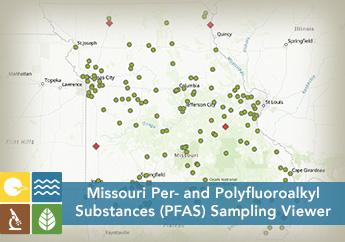
PFAS are a group of manmade fluorinated chemicals that have been used in industry and consumer products since the 1940s. Because of their ability to repel both water and oil, these chemicals have been found in industrial applications and products, such as non-stick cookware, carpet, clothing, furniture fabrics, waxes, cleaning products and some firefighting foams. There are thousands of different PFAS, the three most studied being perfluorooctanoic acid (PFOA), perfluorooctanesulfonic acid (PFOS) and polytetrafluoroethylene (Teflon).
Emerging Concerns
Due to their widespread use, PFAS can be found in our water, soil, air and food, in addition to materials found in our homes or workplaces. Many PFAS break down very slowly and can build up in people, animals and the environment over time. Scientific studies have shown that exposure to some PFAS in the environment may be linked to harmful health effects in humans and animals.
MoDNR Actions
For general or media inquiries regarding the department’s PFAS efforts, please contact the department's Office of Communications at 573-751-1010 or by email at communications@dnr.mo.gov
PFAS Workgroup
The Per- and Polyfluoroalkyl Substances (PFAS) Workgroup is a stakeholder workgroup organized by the department in response to stakeholder concerns regarding this emerging contaminant. The workgroup is made up of department team members and Missouri experts in the fields of wastewater, stormwater, drinking water, chemistry, analytical methods and environmental advocacy. The workgroup will be mainly dedicated to developing policies and tools regarding PFAS.
Drinking Water Monitoring

Since 2013, the department has performed PFAS occurrence monitoring projects for public drinking water supplies through federal and voluntary sampling programs. To date, these sampling efforts represent public water supplies that serve more than 76% of Missouri’s population. The department's Missouri PFAS Viewer Tool identifies the location of voluntary sampling for PFAS in public drinking water systems in Missouri. Users can browse the map to explore PFAS-related data maintained by the department. The department is continuing efforts to characterize the extent of PFAS contamination at public water systems in Missouri.
Wastewater and Stormwater Permitting
Beginning in 2022, the department began a voluntary PFAS sampling program for facilities renewing existing wastewater or stormwater permits. The intent of this program is to help facilities that potentially have PFAS in their effluent, have data in place once EPA issues regulatory standards for PFAS chemicals in wastewater. For more information, please contact the Water Protection Program at 573-522-2575.
Special Projects Funding
Missouri will be allotted approximately $237 million to distribute for Clean Water State Revolving Fund and Drinking Water State Revolving Fund projects, including funds for specific projects like treating emerging contaminants such as PFAS. The department will detail program eligibilities and offerings in the Clean Water and Drinking Water State Revolving Funds Intended Use Plans, which will be finalized in October 2022. For more information, please contact the Financial Assistance Center at 573-751-1192 or fac@dnr.mo.gov.
Investigations
The department will use resources like EPA's PFAS Analytic Tools during investigations to identify potential manufacturers, transporters or handlers of PFAS when evaluating potential releases into the environment.
EPA Actions
For more information about what EPA is doing to address PFAS, review PFAS Strategic Roadmap: EPA's Commitments to Action 2021-2024.
Health Advisories
On June 15, 2022, EPA released two drinking water health advisories for four PFAS: PFOA and PFOS and GenX and PFBS. While these health advisories are non-enforceable and non-regulatory, they provide information on levels that can cause human health effects if exposed over one’s entire lifetime. Health advisory levels also take into account exposures through sources other than drinking water.
| PFAS | Interim or Final Health Advisory Level | Concentration in Drinking Water (ppt)1 |
|---|---|---|
| PFOA | Interim Updated | 0.004 |
| PFOS | Interim Updated | 0.02 |
| GenX | Final | 10 |
| PFBS | Final | 2,000 |
1Current analytical detection limits for PFOA and PFOS in drinking water are well above the health advisory levels issued by EPA.
Regulatory Standards
EPA announced it will release a draft drinking water rule with proposed regulatory standards (maximum contaminant levels, or MCLs) for PFOA and PFOS by fall 2022. These standards would become enforceable upon finalization of the rule, which EPA proposed to occur by fall 2023. At this time, there are no federal MCLs for PFOA, PFOS, GenX or PFBS in drinking water.
PFAS Dashboard
EPA developed the PFAS Analytic Tools as part of a cross-agency effort to address PFAS and make that work transparent. The tools are intended to provide states, tribes, federal partners and the public with information on PFAS manufacture, release and occurrence in the environment as well as facilities potentially handling PFAS. These tools combine multiple data sources, so that the user can explore various PFAS data in a region, state or community. This application does not include all PFAS data, information or resources.
Navigation
- About Us
- Beaches
- Calendar
- Careers
- Commissions, Boards, Councils
- Communications
- Compliance Assistance and Enforcement
- Contaminant Spotlight
- Data and e-Services
- Disaster Resources
- Document Search
- Earth Day
- Fees
- Financial Assistance Opportunities
- Forms and Applications
- Frequently Asked Questions
- Get Involved
- Laws, Rules and Regulations
- Missouri DNR Photo Contest
- Missouri Resources
- Monitoring
- Permits, Certifications, Registrations and Licenses
- Professional Certifications and Trainings
- Public Notices/ Public Comment Periods
- Publications and Fact Sheets
- Reporting
- Sites of Interest
- State Fair
- Success Stories
- Sunshine Law Requests
- What We're Doing
Related Links
Contact Information
Water Protection Program
Division of Environmental Quality
P.O. Box 176
Jefferson City, MO 65102-0176
United States
